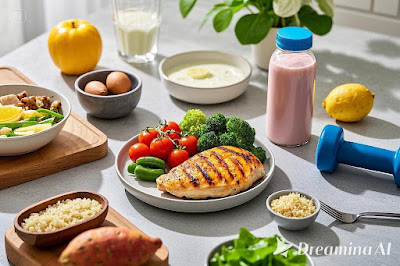Building muscle requires a strategic combination of proper training and precise nutrition. While the gym provides the stimulus, your diet delivers the building blocks necessary for muscle growth, recovery, and overall performance. This comprehensive guide merges traditional wisdom with cutting-edge nutritional science to help you achieve your muscle-building goals safely and effectively.
1. Protein: The Building Blocks of Muscle
Scientific research consistently shows that protein intake is crucial for muscle protein synthesis (MPS). The International Society of Sports Nutrition recommends:
- 1.6-2.2g of protein per kilogram of body weight daily for active individuals
- For a 70kg (154lb) person, this means 112-154g of protein daily
Quality Protein Sources:
- Animal-based: Chicken (31g per 100g), eggs (6g per egg), fish (22-25g per 100g)
- Plant-based: Lentils (9g per 100g), quinoa (4.4g per 100g), tempeh (19g per 100g)
- Dairy: Greek yogurt (10g per 100g), cottage cheese (11g per 100g)
Timing Considerations:
- Distribute protein intake across 4-6 meals
- Aim for 20-40g of protein per meal
- Include a protein source with each meal
2. Strategic Carbohydrate Implementation
Carbohydrates play multiple roles in muscle building:
- Fuel high-intensity workouts
- Spare protein from being used for energy
- Trigger insulin release, which helps drive nutrients into muscle cells
Daily Recommendations:
- Moderate to high-intensity training: 4-7g/kg body weight
- Lower intensity training: 3-5g/kg body weight
Optimal Sources:
- Complex Carbohydrates:
- Sweet potatoes
- Brown rice
- Quinoa
- Oats
- Whole grain pasta
- Fast-Acting Carbs (around workouts):
- White rice
- Bananas
- Sports drinks (when needed)
- Rice cakes
3. Essential Fats for Hormone Optimization
Dietary fats are crucial for:
- Testosterone production
- Vitamin absorption
- Inflammation management
- Cell membrane health
Recommended intake: 0.5-1.5g/kg body weight daily
Key Sources:
- Omega-3 rich: Salmon, sardines, chia seeds
- Monounsaturated: Avocados, olive oil, nuts
- Medium-chain triglycerides: Coconut oil
4. Precision Nutrition Timing
Pre-Workout (1-2 hours before):
- 20-40g protein
- 40-60g complex carbs
- Low fat
- Example: Greek yogurt with banana and honey
Post-Workout (within 30 minutes):
- 20-40g fast-digesting protein
- 40-60g quick carbs
- Example: Whey protein shake with dextrose or banana
5. Hydration Strategy
Proper hydration is essential for:
- Nutrient transport
- Recovery
- Performance
- Protein synthesis
Daily Requirements:
- Minimum 3-4 liters of water
- Additional 500-750ml per hour of training
- Electrolyte replacement during intense sessions
6. Micronutrient Optimization
Key micronutrients for muscle growth:
- Vitamin D: 2000-4000 IU daily
- Zinc: 15-30mg daily
- Magnesium: 400-500mg daily
- B-vitamins: Through varied diet or B-complex supplement
7. Sample Advanced Muscle-Building Meal Plan
Breakfast (7:00 AM):
- 4 whole eggs + 2 egg whites
- 1 cup oatmeal with berries
- 1 tablespoon almond butter
Macros: 40g protein, 45g carbs, 25g fat
Mid-Morning (10:00 AM):
- Greek yogurt with granola
- 1 apple
- Handful of almonds
Macros: 25g protein, 35g carbs, 12g fat
Lunch (1:00 PM):
- 6oz chicken breast
- 1 cup brown rice
- 2 cups mixed vegetables
- 1 tablespoon olive oil
Macros: 45g protein, 50g carbs, 15g fat
Pre-Workout (4:00 PM):
- Whey protein shake
- Banana
- Rice cakes
Macros: 25g protein, 30g carbs, 2g fat
Post-Workout (6:30 PM):
- Whey isolate shake
- Dextrose or highly branched cyclic dextrin
Dinner (7:30 PM):
- 8oz salmon
- Sweet potato
- Asparagus
- 1 tablespoon coconut oil
Before Bed (10:00 PM):
- Casein protein or cottage cheese
- 1 tablespoon almond butter
8. Progress Monitoring
Track these metrics weekly:
- Body weight
- Body measurements
- Progress photos
- Strength gains
- Energy levels
- Sleep quality
9. Common Mistakes to Avoid
- Undereating calories
- Insufficient protein intake
- Poor food quality
- Inadequate vegetable intake
- Neglecting hydration
- Inconsistent meal timing
10. Special Considerations
Vegetarian/Vegan Athletes:
- Combine protein sources for complete amino acid profiles
- Consider B12 supplementation
- Monitor iron intake
- Include plant-based protein powders
Food Allergies/Intolerances:
- Work with a registered dietitian
- Use alternative protein sources
- Consider enzyme supplements if needed
Conclusion
Building muscle requires a systematic approach to nutrition that goes beyond simply eating more protein. By following these evidence-based guidelines and adjusting them to your individual needs, you can optimize your body's ability to build and maintain muscle mass while minimizing fat gain.
Remember: Track your progress, adjust as needed, and maintain consistency. Consider working with a registered dietitian or sports nutritionist to fine-tune this approach to your specific needs and goals.
Always consult with healthcare professionals before starting any new diet program, especially if you have underlying health conditions or take medications.

Comments